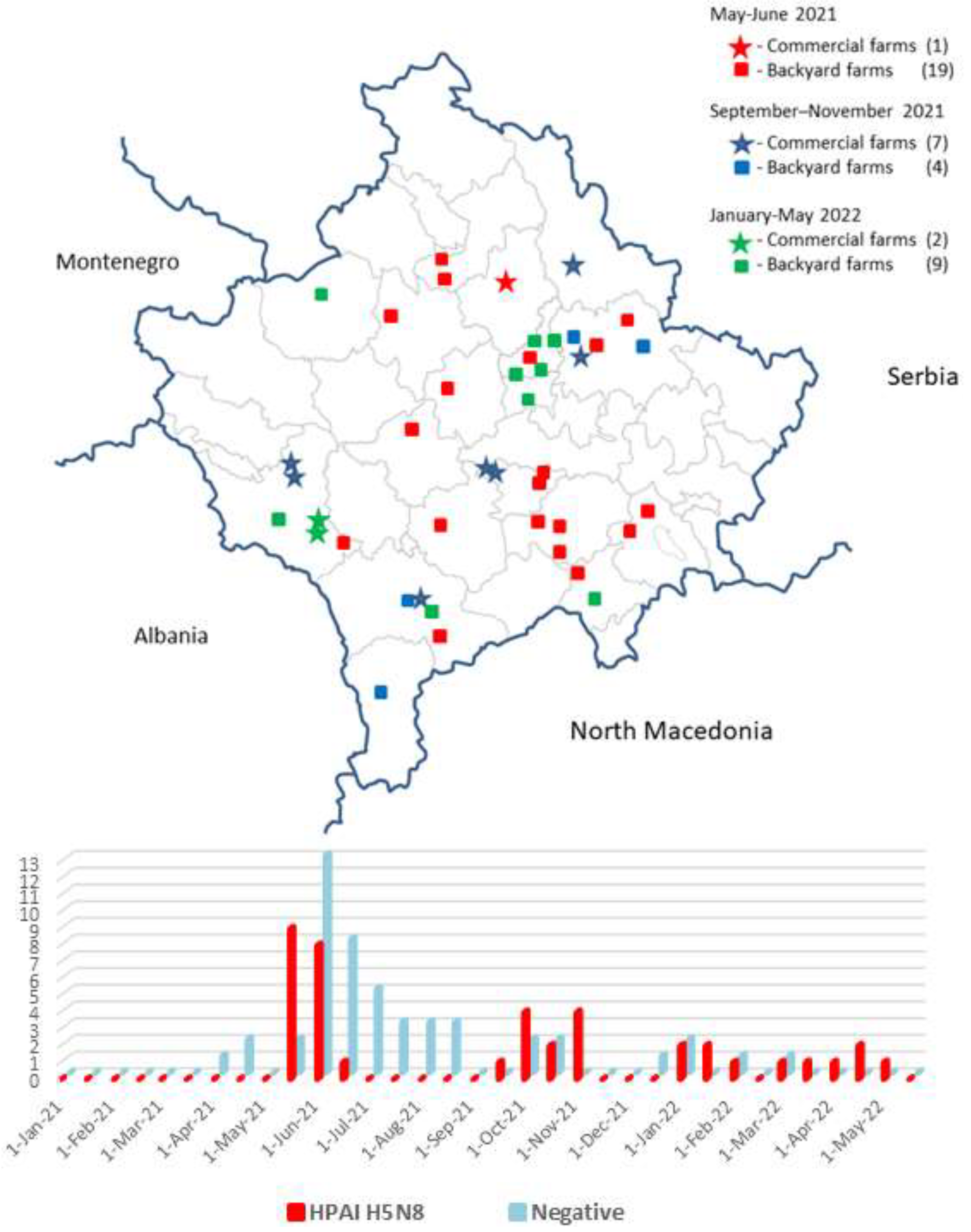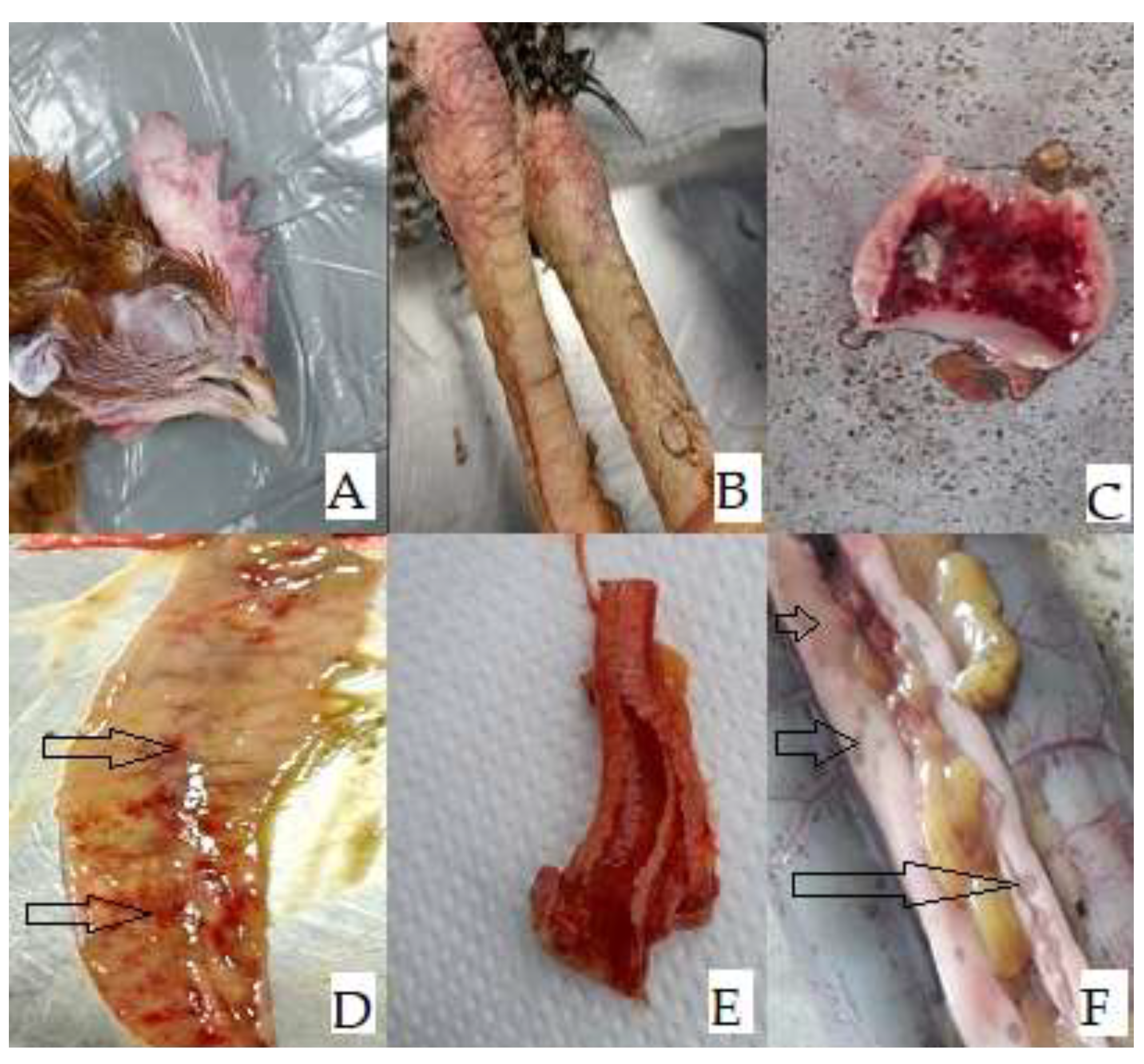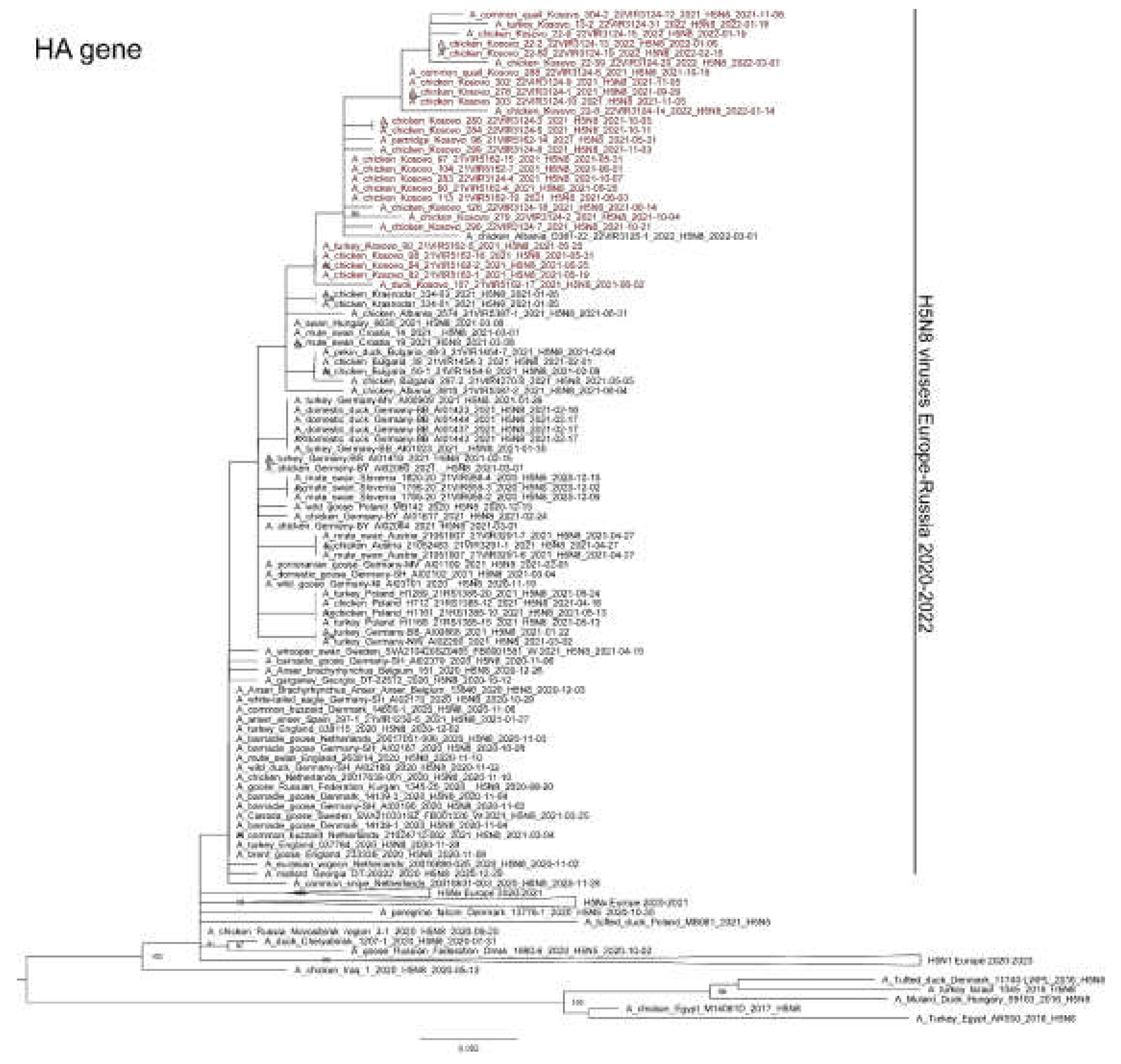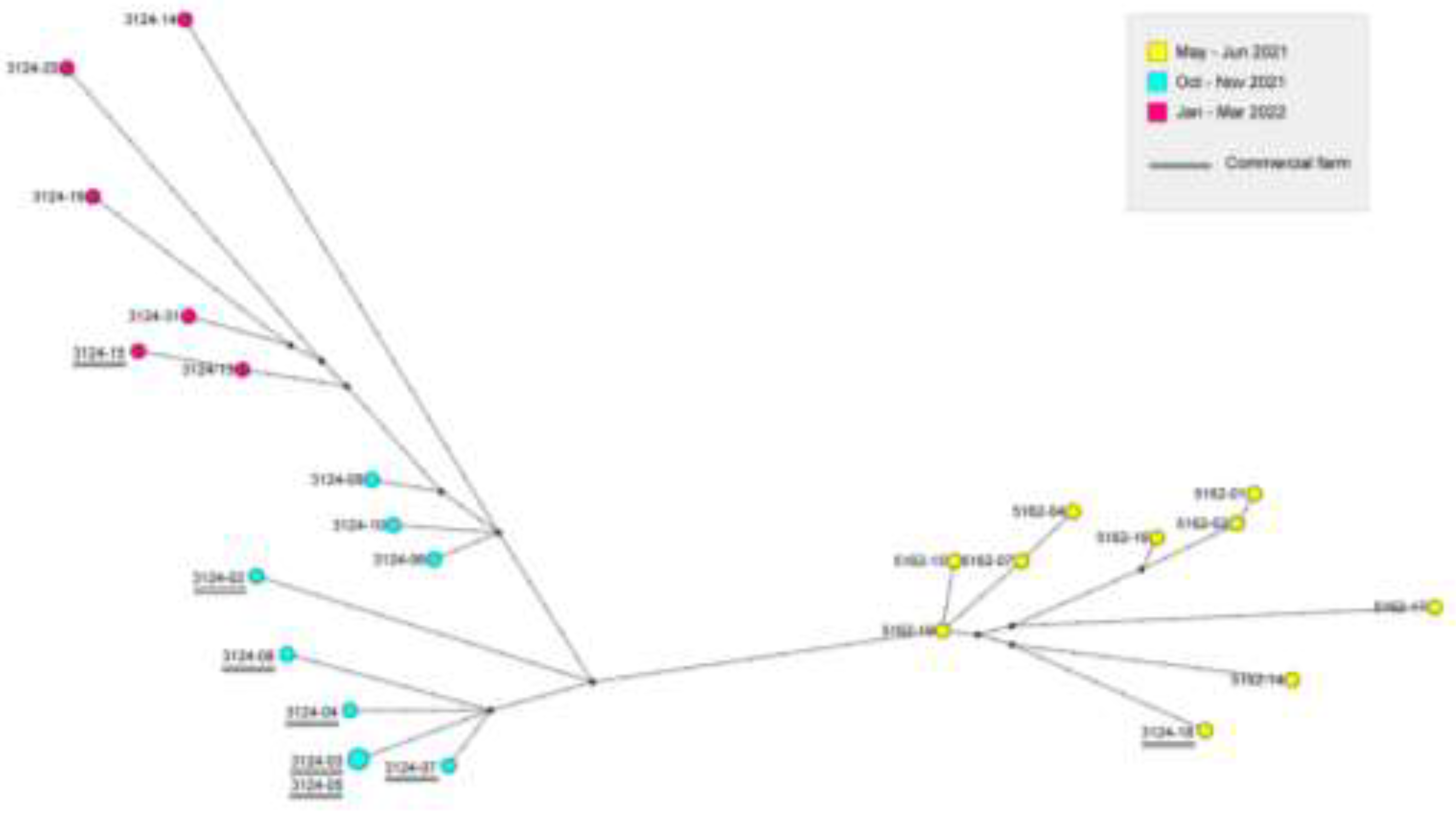Submitted:
22 August 2023
Posted:
22 August 2023
You are already at the latest version
Abstract
Keywords:
1. Introduction
2. Materials and Methods
2.1. Laboratory Analysis
2.1.1. H5 Sanger Sequencing of the Cleavage Site and HPAI Identification
2.1.2. Whole Genome Sequencing, Phylogenetic and Network Analyses
2.2. Ethical Statement
3. Results
3.1. Distribution of Positive Farms
3.2. Necropsy Finding
3.3. Virus Identification and Pathotyping
3.4. Phylogenetic and Network Analyses
4. Discussion
Supplementary Materials
Author Contributions
Funding
Acknowledgments
Conflicts of Interest
References
- Fouchier, R.A.; Munster, V.J. Epidemiology of low pathogenic avian influenza viruses in wild birds. Rev. sci. tech. Off. int. Epiz 2009, 28, 49–58. [Google Scholar] [CrossRef] [PubMed]
- Lee, D.H; Bertran, K.; Kwon, J.H.; Swayne, D.E. Evolution, global spread, and pathogenicity of highly pathogenic avian influenza H5Nx clade 2.3.4.4. J. Vet. Sci. 2019, 18, 269–280. [Google Scholar] [CrossRef] [PubMed]
- Lee, D.H.; Criado, M.F.; David, F.S. Pathobiological Origins and Evolutionary History of Highly Pathogenic Avian Influenza Viruses. Cold. Spring Harb. Perspect. Med. 2021, 11, a038679. [Google Scholar] [CrossRef]
- WHO (World Health Organization). Cumulative number of confirmed human cases for avian influenza A(H5N1) reported to WHO, 2003-2021, 15 April 2021," https://www.who.int/publications/m/item/cumulative-number-of-confirmed-human-cases-for-avian-influenza-a(h5n1)-reported-to-who-2003-2021-15-april-2021, 2021. 15 April.
- The Global Consortium for H5N8 and Related Influenza Viruses. Role for migratory wild birds in the global spread of avian influenza H5N8. Science 2016, 354, 213–217. [Google Scholar] [CrossRef] [PubMed]
- Baek, Y.G.; Lee, Y.N.; Lee, D.H.; Shin, J.I.; Lee, J.H.; Chung, D.H.; Lee, E.-K.; Heo, G.-B.; Sagong, M.; Kye, S.J.; Lee, K.N.; Lee, M.H.; Lee, Y.J. Multiple Reassortants of H5N8 Clade 2.3.4.4b Highly Pathogenic Avian Influenza Viruses Detected in South Korea during the Winter of 2020–2021. Viruses 2021, 13, 490. [Google Scholar] [CrossRef]
- Kwon, J.H.; Lee, D.H.; Swayne, D. E.; Noh, J.-Y.; Yuk, S.S.; Erdene-Ochir, T.O.; Hong, W.T.; Jeong, J.H.; Jeong, S.; Gwon, G.B.; Song, C.S. Highly Pathogenic Avian Influenza A(H5N8) Viruses Reintroduced into South Korea by Migratory Waterfowl, 2014–2015. Emerg. Infect. Dis. 2016, 22, 507–510. [Google Scholar] [CrossRef]
- Fan, S.; Zhou, L.; Wu, D.; Gao, X.; Pei, E.; Wang, T.; Gao, Y.; Xia, X. A novel highly pathogenic H5N8 avian influenza virus isolated from a wild duck in China. Influenza Other Respir. Viruses 2014, 8, 646–653. [Google Scholar] [CrossRef]
- Lee, D.H.; Sharshov,K. ; Swayne, D.E.; Kurskaya, O.; Sobolev, I.; Kabilov, M.; Alekseev, A.; Irza, V; Shestopalov, A. Novel Reassortant Clade 2.3.4.4 Avian Influenza A(H5N8) Virus in Wild Aquatic Birds, Russia, 2016. Emerg. Infect. Dis. 2017, 23, 359–360. [Google Scholar] [CrossRef]
- Koethe, S.; Ulrich, L.; Ulrich, R.; Amler, S.; Graaf, A.; Harder, T.C.; Grund, C.; Mettenleiter, T.C.; Conraths, F.J.; Beer, M.; Globig, A. Modulation of lethal HPAIV H5N8 clade 2.3.4.4B infection in AIV pre-exposed mallards. Emerg. Microbes Infect. 2020, 9, 180–193. [Google Scholar] [CrossRef]
- Świętoń, E.; Fusaro, A.; Shittu, I.; Niemczuk, K.; Zecchin, B.; Joannis, T.; Bonfante, F.; Śmietanka, K.; Terregino, C. Sub-Saharan Africa and Eurasia Ancestry of Reassortant Highly Pathogenic Avian Influenza A(H5N8) Virus, Europe, December 2019. Emerg. Infect. Dis. 2020, 26, 1557–1561. [Google Scholar] [CrossRef]
- Brown, I.; Mulatti, P.; Smietanka, K.; Staubach, C.; Willeberg, P.; Adlhoch, C.; Candiani, D.; Fabris, C.; Zancanaro, G.; Morgado, J.; Verdonck, F. Avian influenza overview October 2016–August 2017. EFSA J. 2017, 15, 5018. [Google Scholar] [CrossRef]
- Adlhoch, C.; Fusaro, A.; Kuiken, T.; Monne, I.; Smietanka, K.; Staubach, C.; Guajardo, M.I.; Baldinelli, F. Avian influenza overview February – August 2019. EFSA J. 2019, 17, 5843. [Google Scholar]
- Adlhoch, C.; Fusaro, A.; Gonzales, J.L.; Kuiken, T.; Marangon, S.; Mirinaviciute, G.; Niqueux, É.; Stahl, K.; Staubach, C.; Terregino, C.; Broglia, A.; Baldinelli. F. Avian influenza overview December 2022 – March 2023. EFSA J.l 2023, 21, 07917. [Google Scholar] [CrossRef]
- Kleyheeg, E.; Slaterus, R.; Bodewes, R.; Rijks, J.M.; Spierenburg, M.A.; Beerens, N.; Kelder, L.; Poen, M.P.; Stegeman, J. A.; Fouchier, R.A.; Kuiken, T.; van der Jeugd, H.P. Deaths among Wild Birds during Highly Pathogenic Avian Influenza A(H5N8) Virus Outbreak, the Netherlands. Emerg. Infect. Dis. 2017, 23, 2050–2054. [Google Scholar] [CrossRef] [PubMed]
- Adlhoch, C.; Fusaro, A.; Gonzales, J.L.; Kuiken, T.; Marangon, S.; Niqueux, É.; Staubach, C.; Terregino, C.; Aznar, I.; Guajardo, I.M.; Baldinelli, F. Avian influenza overview March – June 2022. EFSA J. 2022, 20, 7415–2022. [Google Scholar]
- Zecchin, B.; Goujgoulova, G.; Monne, I.; Salviato, A.; Schivo, A.; Slavcheva, L.; Pastori, A.; Brown, I.H.; Lewis, N.S.; Terregino, C.; Fusaro, A. Evolutionary Dynamics of H5 Highly Pathogenic Avian Influenza Viruses (Clade 2.3.4.4B) Circulating in Bulgaria in 2019–2021. Viruses 2021, 13, 2086. [Google Scholar] [CrossRef]
- Stoimenov, G.M.; Goujgoulova, G.V.; Nikolov, B.; Hristov, K.; Teneva, A. Pathological changes in natural infection of pheasants with highly pathogenic avian influenza A (H5N8) in Bulgaria. J. Vet. Res. 2019, 63, 497–502. [Google Scholar] [CrossRef]
- Adlhoch, C.; Fusaro, A.; Gonzales, J.L.; Kuiken, T.; Marangon, S.; Niqueux, É.; Staubach, C.; Terregino, C.; Aznar, I.; Guajardo, I.M.; Baldinelli, F. Avian influenza overview May – September 2021. EFSA J. 2022, 20, e07122. [Google Scholar]
- Heine, H. G.; Foord, A. J.; Wang, J.; Valdeter, S.; Walker, S.; Morrissy, C.; Wong, F.Y.; Meehan, B. Detection of highly pathogenic zoonotic influenza virus H5N6 by reverse-transcriptase quantitative polymerase chain reaction. Virol. J. 2015, 8, 12–18. [Google Scholar] [CrossRef]
- Slomka, M. J.; Pavlidis, T.; Banks, J.; Shell, W.; McNally, A.; Essen, S.; Brown, I.H. Validated H5 Eurasian real-time reverse transcriptase-polymerase chain reaction and its application in H5N1 outbreaks in 2005-2006. Avian Dis. 2007, 51, 373–377. [Google Scholar] [CrossRef]
- Van Borm, S.; Suarez, D.L.; Boschmans, M.; Ozhelvaci, O.; Marché, S.; van den Berg, T.P. Rapid detection of Eurasian and American H7 subtype influenza A viruses using a single TaqManMGB real-time RT-PCR. Avian Dis. 2010, 54, 632–638. [Google Scholar] [CrossRef] [PubMed]
- Payungporn, S.; Chutinimitkul, S.; Chaisingh, A.; Damrongwantanapokin, S.; Buranathai, C.; Amonsin, A.; Theamboonlers, A.; Poovorawan, Y. Single step multiplex real-time RT-PCR for H5N1 influenza A virus detection. J. Virol. Methods 2006, 131, 143–147. [Google Scholar] [CrossRef] [PubMed]
- James, J.; Slomka, M.J.; Reid, S.M.; Thomas, S.S.; Mahmood, S.; Byrne, A.M.P.; Cooper, J.; Russell, C.; Mollett, B.C.; Agyeman-Dua, E.; Essen, S.; Brown, I.H.; Brookes, S.M. Development and Application of Real-Time PCR Assays for Specific Detection of Contemporary Avian Influenza Virus Subtypes N5, N6, N7, N8, and N9. Avian Dis. 2019, 6, 209–218. [Google Scholar] [CrossRef] [PubMed]
- Slomka, M.J.; Coward, V.J.; Banks, J.; Lӧndt, B.Z.; Brown, I.H.; Voermans, J.; Koch, G.; Handberg, K.J.; JØrgensen, P.H.; Cherbonnel-Pansart, M.; Jestin, V.; Cattoli, G.; Capua, I.; Ejdersund, A.; Thorén, P.; Czifra,G. Identification of sensitive and specific avian influenza polymerase chain reaction methods through blind ring trials organized in the European Union. Avian Dis. 2007, 51, 227–234. [Google Scholar] [CrossRef]
- Zhou, B.; Donnelly, M.E.; Scholes, D.T.; George, K.S.; Hatta, M.; Kawaoka, Y.; Wentworth, D.E.; St. George, K.; Hatta, M.; Kawaoka, Y.; Wentworth, D.E. Single-Reaction Genomic Amplification Accelerates Sequencing and Vaccine Production for Classical and Swine Origin Human Influenza A Viruses” J. Virol. 2009, 83, 10309–10313.
- Van der Auwera, G.; Carneiro, M.; Hartl, C.; Poplin, R.; Del Angel, G.; Levy-Moonshine, A.; Jordan, T.; Shakir, K.; Roazen, D.; Thibault, J.; Banks, E.; Garimella, K.; Altshuler, D.; Gabriel, S.; DePristo, M. From FastQ data to high confidence variant calls: The Genome Analysis Toolkit best practices pipeline. Curr. Protoc. Bioinforma. 2013, 43, 11–10. [Google Scholar] [CrossRef] [PubMed]
- Depristo, M.A.; Banks, E.; Poplin, R.E.; Garimella, K.V.; Maguire, J.R.; Hartl, C.; Philippakis, A.A.; Del Angel, G.; Rivas, M.A.; Hanna, M.; Mckenna, A.; Fennell, T.J.; Kernytsky, A.M.; Sivachenko, A.Y.; Cibulskis, K.; Gabriel, S.B.; Altshuler, D.; Daly, M.J. A framework for variation discovery and genotyping using next-generation DNA sequencing data. Nat. Genet. 2011, 43, 491–498. [Google Scholar] [CrossRef]
- McKenna, A.; Hanna, M.; Banks, E.; Sivachenko, A.; Cibulskis, K.; Kernytsky, A;. Garimella, K.; Altshuler, D.; Gabriel, S.; Daly, M.; DePristo, M.A. The Genome Analysis Toolkit: A MapReduce framework for analyzing next-generation DNA sequencing data. Genome Res. 2010, 20, 1297–303.
- Wilm, A.; Aw, P.P.K.; Bertrand, D,; Yeo, G.H.T.; Ong, S.H.; Wong, C.H.; Khor, C.C.; Petric, R.; Hibberd, M.L.; Nagarajan, N. LoFreq: A sequence-quality aware, ultra-sensitive variant caller for uncovering cell-population heterogeneity from high-throughput sequencing datasets. Nucleic. Acids Res. 2012, 40, 11189–11201. [CrossRef]
- Katoh, K.; Standley, D.M. MAFFT multiple sequence alignment software version 7: Improvements in performance and usability. Mol. Biol. Evol. 2013, 30, 772–780. [Google Scholar] [CrossRef]
- Bandelt, H.J.; Forster, P.; Röhl, A. Median-joining networks for inferring intraspecific phylogenies. Mol. Biol. Evol., 1999, 16, 37–48. [Google Scholar] [CrossRef]
- Adlhoch, C.; Fusaro, A.; Gonzales, J.L.; Kuiken, T.; Marangon, S.; Niqueux, É.; Staubach, C.; Terregino, C.; Aznar, I.; Guajardo, I.M.; Baldinelli, F. Avian influenza overview September – December 2021. EFSA J. 2021, 19, 12–e7108. [Google Scholar] [CrossRef]
- Pyankova, O.G.; Susloparov, I.M.; Moiseeva, A.A.; Kolosova, N.P.; Onkhonova, G.S.; Danilenko, A.V.V.; Vakalova, E.V.; Shendo, G.L.; Nekeshina, N.N.; Noskova, L.N.; Demina, J.V.; Frolova, N.V.; Gavrilova, E.V.; Maksyutov, R.A.; Ryzhikov, A.B. Isolation of clade 2.3.4.4b A(H5N8), a highly pathogenic avian influenza virus, from a worker during an outbreak on a poultry farm, Russia, December 2020. Euro Surveill. 2021, 26, 2100439. [CrossRef]
- WHO (World Health Organization). Avian influenza A(H5N8) infects humans in Russian Federation. WHO, Copenhagen, 2021.
- Floyd, T.; Banyard, A.C.; Lean, F.Z.X.; Byrne, A.M.P; Fullick, E.; Whittard, E.; Mollett, B. C.; Bexton, S.; Swinson, V.; Macrelli, M.; Lewis, N. S.; Reid, S. M.; Núñez, A.; Duff, J. P.; Hansen, R.; Brown, I. H. Encephalitis and Death in Wild Mammals at a Rehabilitation Center after Infection with Highly Pathogenic Avian Influenza A(H5N8) Virus, United Kingdom. Emerg. Infect. Dis. 2021; 27, 2856–2863. [CrossRef]
- Herve, S.; Schmitz, A.; Briand, F.X.; Gorin, S.; Quéguiner, S.; Niqueux, É.; Paboeuf, F.; Scoizec, A.; Le Bouquin-Leneveu, S.; Eterradossi, N.; Simon, G. Serological Evidence of Backyard Pig Exposure to Highly Pathogenic Avian Influenza H5N8 Virus during 2016-2017 Epizootic in France. Pathogens 2021, 10, 621. [Google Scholar] [CrossRef]
- Schülein, A.; Ritzmann, M.; Christian, J.; Schneider, K.; Neubauer-Juric, A. Exposure of wild boar to Influenza A viruses in Bavaria: Analysis of seroprevalences and antibody subtype specificity before and after the panzootic of highly pathogenic avian influenza viruses A (H5N8). Zoonoses Public Health 2021, n/a. [CrossRef]
- Adlhoch, C.; Fusaro, A.; Gonzales, J.L.; Kuiken, T.; Meliodu, A.; Mirinaviciute, G.; Niqueux, É.; Stahl, K.; Staubach, C.; Terregino, C.; Baldinelli. F.; Broglia, A.; Kohnle, L. Avian influenza overview April - June 2023. EFSA J. 2023, 21, e08191. [Google Scholar] [CrossRef] [PubMed]
- Fusaro, A.; Monne, I.; Mulatti, P.; Zecchin, B.; Bonfanti, L.; Ormelli, S.; Milani, A.; Cecchettin, K.; Lemey, P.; Moreno, A.; Massi, P.; Dorotea, T.; Marangon, S. and Terregino, C. Genetic Diversity of Highly Pathogenic Avian Influenza A(H5N8/H5N5) Viruses in Italy, 2016–17. Emerg. Infect. Dis. 2017, 23, 1543–1547. [Google Scholar] [CrossRef] [PubMed]
- Shi, W.; Gao, G.F. Emerging H5N8 avian influenza viruses. Science 2021, 372, 784–786. [Google Scholar] [CrossRef] [PubMed]




| Virus | District | Category | ID | IZSVe-ID | Date | Genome | Accession number |
|---|---|---|---|---|---|---|---|
| A/partridge/Kosovo/96_21VIR5162-14/2021 | Prizren | Backyard | 96 | 5162-14 | 31/05/2021 | Complete | EPI_ISL_3128524 |
| A/chicken/Kosovo/97_21VIR5162-15/2021 | Gjilan | Backyard | 97 | 5162-15 | 31/05/2021 | Complete | EPI_ISL_3128525 |
| A/chicken/Kosovo/98_21VIR5162-16/2021 | Mitrovica | Backyard | 98 | 5162-16 | 31/05/2021 | Complete | EPI_ISL_3128526 |
| A/duck/Kosovo/107_21VIR5162-17/2021 | Ferizaj | Backyard | 107 | 5162-17 | 02/06/2021 | Complete | EPI_ISL_3128527 |
| A/chicken/Kosovo/113_21VIR5162-19/2021 | Ferizaj | Backyard | 113 | 5162-19 | 03/06/2021 | Complete | EPI_ISL_3128528 |
| A/chicken/Kosovo/82_21VIR5162-1/2021 | Mitrovica | Backyard | 82 | 5162-1 | 19/05/2021 | Complete | EPI_ISL_3128529 |
| A/chicken/Kosovo/84_21VIR5162-2/2021 | Ferizaj | Backyard | 84 | 5162-2 | 25/05/2021 | Complete | EPI_ISL_3128530 |
| A/chicken/Kosovo/90_21VIR5162-4/2021 | Prizren | Backyard | 90 | 5162-4 | 25/05/2021 | Complete | EPI_ISL_3128531 |
| A/chicken/Kosovo/104_21VIR5162-7/2021 | Prizren | Backyard | 104 | 5162-7 | 01/06/2021 | Complete | EPI_ISL_3128532 |
| A/chicken/Kosovo/279_22VIR3124-2/2021 | Prizren | Commercial | 279 | 3124-2 | 04/10/2021 | Complete | EPI_ISL_12176839 |
| A/chicken/Kosovo/280_22VIR3124-3/2021 | Gjakova | Commercial | 280 | 3124-3 | 05/10/2021 | Complete | EPI_ISL_12176840 |
| A/chicken/Kosovo/283_22VIR3124-4/2021 | Ferizaj | Commercial | 283 | 3124-4 | 07/10/2021 | Complete | EPI_ISL_12176841 |
| A/chicken/Kosovo/284_22VIR3124-5/2021 | Gjakova | Commercial | 284 | 3124-5 | 11/10/2021 | Complete | EPI_ISL_12176843 |
| A/common_quail/Kosovo/288_22VIR3124-6/2021 | Prizren | Backyard | 288 | 3124-6 | 18/10/2021 | Complete | EPI_ISL_12176844 |
| A/chicken/Kosovo/290_22VIR3124-7/2021 | Pristina | Commercial | 290 | 3124-7 | 21/10/2021 | Complete | EPI_ISL_12176845 |
| A/chicken/Kosovo/299_22VIR3124-8/2021 | Ferizaj | Commercial | 299 | 3124-8 | 03/11/2021 | Complete | EPI_ISL_12176846 |
| A/chicken/Kosovo/302_22VIR3124-9/2021 | Pristina | Backyard | 302 | 3124-9 | 05/11/2021 | Complete | EPI_ISL_12176847 |
| A/chicken/Kosovo/303_22VIR3124-10/2021 | Pristina | Backyard | 303 | 3124-10 | 05/11/2021 | Complete | EPI_ISL_12176848 |
| A/chicken/Kosovo/22-2_22VIR3124-13/2022 | Pristina | Backyard | 22-2 | 3124-13 | 06/01/2022 | Complete | EPI_ISL_12176850 |
| A/chicken/Kosovo/22-8_22VIR3124-14/2022 | Pristina | Backyard | 22-8 | 3124-14 | 14/01/2022 | Complete | EPI_ISL_12176851 |
| A/chicken/Kosovo/22-9_22VIR3124-15/2022 | Gjakova | Commercial | 22-9 | 3124-15 | 19/01/2022 | Complete | EPI_ISL_12176852 |
| A/chicken/Kosovo/126_22VIR3124-18/2021 | Mitrovica | Commercial | 126 | 3124-18 | 14/06/2021 | Complete | EPI_ISL_12176853 |
| A/chicken/Kosovo/22-50_22VIR3124-19/2022 | Prizren | Backyard | 22-50 | 3124-19 | 15/02/2022 | Complete | EPI_ISL_12176854 |
| A/chicken/Kosovo/22-59_22VIR3124-20/2022 | Pristina | Backyard | 22-59 | 3124-20 | 01/03/2022 | Complete | EPI_ISL_12176855 |
| A/turkey/Kosovo/13-2_22VIR3124-31/2022 | Prizren | Backyard | 13-2 | 3124-31 | 19/01/2022 | Complete | EPI_ISL_12176931 |
| A/turkey/Kosovo/90_21VIR5162-5/2021 | Prizren | Backyard | 90 | 5162-5 | 25/05/2021 | Partial | EPI_ISL_3142407 |
| A/chicken/Kosovo/278_22VIR3124-1/2021 | Pristina | Commercial | 278 | 3124-1 | 29/09/2021 | Partial | EPI_ISL_12176838 |
| A/common_quail/Kosovo/304-2_22VIR3124-12/2021 | Prizren | Backyard | 304-2 | 3124-12 | 08/11/2021 | Partial | EPI_ISL_12176849 |
Disclaimer/Publisher’s Note: The statements, opinions and data contained in all publications are solely those of the individual author(s) and contributor(s) and not of MDPI and/or the editor(s). MDPI and/or the editor(s) disclaim responsibility for any injury to people or property resulting from any ideas, methods, instructions or products referred to in the content. |
© 2023 by the authors. Licensee MDPI, Basel, Switzerland. This article is an open access article distributed under the terms and conditions of the Creative Commons Attribution (CC BY) license (http://creativecommons.org/licenses/by/4.0/).





